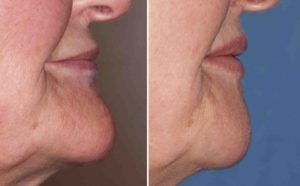Chin reduction is a far less commonly performed procedure than a chin implant or chin augmentation. I would have to estimate that I perform only one chin reduction for every 20 to 25 chin enlargements or enhancements that I do. Not only is it a more uncommon chin procedure, it is also one fraught with many more potential cosmetic complications. Like most of plastic surgery, it is always easier to enlarge a body part than it is to aesthetically reduce it.

In minor cases of excess chin, camouflaging procedures such as cheek implants or rhinoplasty may negate that appearance if those surgeries are indicated. Usually, however, only some form of chin reduction will make the necessary aesthetic difference. Chin reduction surgery is done through an incision under the chin in the skin crease. Muscle is lifted up off of the chin bone (front part of the jaw) and a burr is used to reduce the prominent central area, feathering out into the sides of the chin bone. While any amount of bone can be removed, excess reduction is not advised as this will create a soft tissue redraping problem. Once the bone is reduced, you actually need less muscle and skin underneath. If the muscle is not adequately resected and tightened, you may end up with a ‘witch’s chin’ deformity where the soft tissue sags off of the bone due to lack of support for that amount of tissue. This is a common problem with this operation when done by someone inexperienced and unappreciative of the nuances of the chin reduction procedure. Problems are usually avoided of the bone reduction is not overly aggressive and attention is paid to good soft tissue resuspension and support.
Changing a vertically long chin is done by a different technique than just bone burring. It can be done by either an intraoral wedge reduction osteotomy (non-sliding genioplasty) or from a submental approach where the bottom part of the chin is removed. The submental approach requires meticulous attention to soft tissue reduction and resuspension to see the maximal benefit of the procedure.
I always advise patients that, unlike a chin augmentation where a very big difference can be achieved, chin reduction is about a more subtle change and is never as dramatic a difference. It is, nonetheless, a gratifying procedure when done well and the recovery is no more significant than a chin augmentation. Chin reduction, when combined with other midfacial enhancement procedures at the same time, produces an even better aesthetic change in one’s facial profile.
Dr. Barry Eppley
Indianapolis, Indiana


